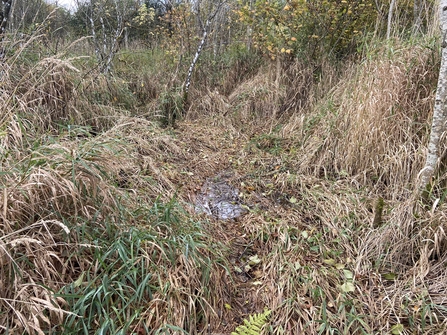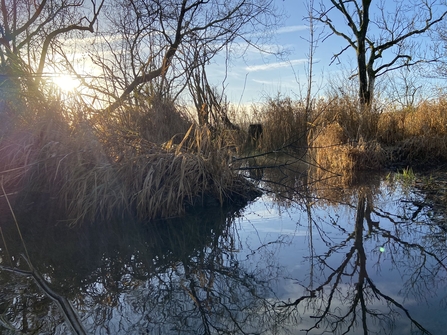Beavers in Cumbria have created this pond © Cumbria Beaver Group
We were pleased to receive this photo which shows beaver activity that's been taking place at the enclosed beaver trial at a private site in south Cumbria. The pond has been created by the beavers felling trees and bushes, to build dams on the stream.
Research suggests that ponds and water pools created from beaver dams can have marked benefits on local water quality. The ponds can help to neutralise acidic run-off, act as sinks for pollutants and increase the self- purification of a watercourse. They can form considerable sediment traps, reducing very strongly erosive run-off and particulate loads in downstream water.
Previously, this was just a damp area with no standing water and just a small stream. The small stream is visible in the bottom left of the picture of the dam (below). The dam is leaky so the water runs out of the dam all along its length and back into the original stream.
Beaver dam in Cumbria © Cumbria Beaver Group
This close up picture shows a beaver dam in detail. This is one way that beavers modify the habitats and landscapes in which they live. In the first instance, these changes can markedly alter the appearance of the local environment but research indicates a positive overall ecological functioning of catchments and river systems.
Beaver adaptations can bring enormous benefits to other species, including otters, water shrews, water voles, birds, invertebrates especially dragonflies, and breeding fish. Beavers naturally create and maintain diverse habitats providing catchment resilience and climate change adaptation. Their leaky dams can hold water in periods of drought, and can regulate flooding by slowing water flow. They can also improve water quality by holding silt behind dams and catching acidic and agricultural run-off.
Beavers forage close to water with activity usually concentrated within 20m of the water’s edge. Beavers fell primarily broad-leafed trees and bushes, in order to eat the cambium (a thin layer between the bark and wood) during the winter and to construct their lodges and dams. Most coppiced trees will regenerate, diversifying the surrounding habitat structure.
Glen and Dragonfly, the two beavers in the enclosed scientific trial at Lowther Estate are doing well. There are currently no sign of kits but we hope there may be, either this year or next year. Collaboration is ongoing with scientists at the Lancaster Environment Centre, Lancaster University to monitor the impacts of the beavers on the estate.

Before: this shows the beaver enclosure at Lowther Castle before beavers were reintroduced © Cumbria Beaver Group

After: the beaver enclosure at Lowther Estate now, after beavers were reintroduced © Cumbria Beaver Group
Cumbria Beaver Group is aware of reports of beaver activity on the Lowther catchment, and work is underway to capture and identify the beaver, following standard procedures outlined in DEFRA's beaver trial licences. It is thought it may be a previously released beaver, which had been assumed dead, as there were no signs of it having breached the secure fencing round the enclosure.
